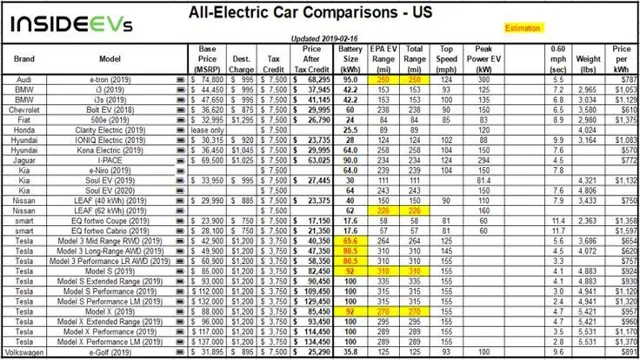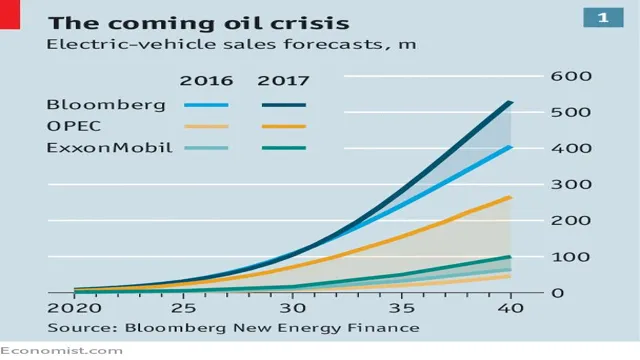Decoding the Age-Old Debate: Electric Car Battery Cycles vs Miles
Have you ever wondered what determines the lifespan of an electric car battery? Is it measured in miles, age, or cycles? It’s a puzzling question that often confuses many car owners. But fear not, we are here to help you understand the difference between electric car battery cycles and miles! Miles driven is a common measure used by traditional vehicles to estimate the lifespan of their engine. However, it’s not the same for electric cars- the lifespan of their batteries is determined by the number of charging and discharging cycles they undergo.
Every time an electric car battery is charged and discharged, it completes one cycle. The more cycles a battery undergoes, the more its capacity to hold a charge decreases. Think of it this way: it’s like your morning cup of coffee.
Every time you brew a pot, the coffee pot loses a little bit of its capacity to brew a full pot. Similarly, every time an electric car battery undergoes a charging and discharging cycle, it loses some of its capacity to hold energy. In conclusion, while traditional cars’ lifespan is measured in miles, electric cars’ battery lifespan is determined by the number of charging and discharging cycles they undergo.
Now that we’ve cleared up that confusion let’s delve deeper into the topic and understand electric car batteries’ lifespan.
Understanding Battery Cycles
Electric car battery cycles versus miles is a topic that confuses many people. Battery cycles refer to how many times a battery can be fully charged and discharged before its performance starts to decline. Miles, on the other hand, refer to how much distance an electric car can travel on a single charge.
These two measures are often interchangeable in people’s minds, but they are quite different. The number of battery cycles a battery can undergo depends on several factors, including temperature, charging habits, and the battery’s chemistry. In general, an electric car battery can last anywhere from 500 to 1,500 cycles, depending on these factors.
However, it’s important to note that battery range can also decline over time as a battery approaches the end of its life. This means that as the battery’s cycles increase, the number of miles it can travel on a single charge may decrease. Overall, it’s essential to understand both battery cycles and miles when considering an electric car’s long-term performance and cost.
Definition and Importance
Battery cycles refer to the process of charging and discharging a battery. Over time, every battery will undergo a certain number of cycles before it starts to degrade, lose its capacity, and eventually become unusable. The number of cycles a battery can undergo before deteriorating depends on various factors such as the type of battery, the quality of the battery, and how it is used.
Lithium-ion batteries, which are commonly used in smartphones, laptops, and electric vehicles, typically have a lifespan of 500 to 1000 charge cycles. Understanding battery cycles is essential to prolong the life of your battery and get the most out of it. By avoiding draining your battery completely and charging it regularly, you can extend the lifespan of the battery and save yourself from having to invest in a new one sooner than expected.
So, don’t overcharge your device, avoid discharging it completely, and always keep your battery in good shape to ensure optimal performance.
Measurement Methods
Battery cycles refer to the number of times a battery can be charged and discharged. The more cycles a battery can handle, the longer its lifespan. It is essential to understand battery cycles because it determines how often you need to replace your batteries.
There are different methods of measuring battery cycles, but the most commonly used is the depth of discharge (DoD). DoD measures the amount of energy drained from the battery during discharge. A shallow discharge increases the number of cycles a battery can endure.
Alternatively, a deep discharge reduces the battery lifespan. Furthermore, temperature and charging rate affect battery cycle life. High temperatures and fast charging speeds decrease the number of cycles a battery can handle.
Knowing the measurement methods is crucial to prolonging the life and capacity of your battery. It ensures that you get the most out of your battery without compromising its performance.
Factors Affecting Battery Cycles
When it comes to understanding battery life, the term “battery cycles” often comes up. This refers to the number of times a battery can be fully charged and discharged. There are many factors that can affect the number of cycles a battery can go through.
One factor is the type of battery chemistry used. Different chemistries have different lifespans and tolerances for charging and discharging. The temperature at which the battery is operated also plays a significant role.
High temperatures can degrade the battery faster and reduce the number of cycles it can handle. Similarly, if a battery is discharged too deeply, it can cause irreversible damage and reduce the number of cycles. On the other hand, keeping the battery in a partial state of charge can also reduce its lifespan.
It’s important to understand these factors to get the most out of your batteries and ensure they last as long as possible.
Implications for Electric Car Owners
As an electric car owner, understanding the relationship between battery cycles and miles is crucial for maintaining the performance and longevity of your electric vehicle. It’s important to note that a battery cycle is not the same as a mile. A battery cycle refers to the number of times a battery can be charged and discharged, while a mile refers to the distance a car can travel.
The number of miles an electric car can travel on a single charge is directly related to the size of the battery and the efficiency of the motor. It’s a common misconception that the more miles an electric car travels, the more battery cycles it will go through. However, this is not necessarily true.
The number of battery cycles an electric car experiences is more closely related to the depth of discharge of the battery. So, if an electric car is constantly charging and discharging to a deep level, it will experience more battery cycles, which can lead to a shorter lifespan for the battery. As an electric car owner, it’s important to balance your driving habits and charging routine to extend the life of your battery and maximize your car’s performance.
How Many Miles Should You Expect?
As an electric car owner, one question that may frequently come to mind is how many miles you can expect on a single charge. While this ultimately depends on factors such as driving habits, weather conditions, and the specific model of your electric vehicle, the average range for electric cars has increased significantly over the years. In fact, many newer models can travel upwards of 200 miles on a full charge.
This means that for most daily commutes and errands, the range on your electric car should be more than enough. However, if you are planning a longer road trip, it is essential to plan your route and charging stops accordingly. With more charging stations popping up all around the world, the rise of electric cars shows no signs of slowing down, as more people opt for an environmentally-friendly and cost-efficient mode of transportation.
Optimizing Battery Life and Performance
As an electric car owner, optimizing the battery life and performance of your vehicle is crucial for maximizing its efficiency and range. To ensure the longevity of your battery, it is important to maintain it properly by keeping it charged between 20-80% and avoiding extreme temperatures. Additionally, reducing unnecessary accessory usage and implementing regenerative braking can also improve your car’s battery life.
When it comes to performance, using the appropriate driving modes and being mindful of your acceleration and braking can make a significant impact on your car’s efficiency. By taking these steps, you can extend the life of your electric car’s battery and improve its overall performance, making it a smart investment for both your wallet and the environment.
Comparing Brands and Models
Electric car battery cycles versus miles vary among different brands and models. Some electric vehicles have battery cells that last longer and provide more range while others have shorter battery lives. It’s important to do your research and compare the specifications of each vehicle before making a purchase.
Generally, the battery cycle lifespan ranges from 500 to 1000 cycles, but this can vary depending on the quality of the battery and how it is used. Additionally, the number of miles driven per cycle can also vary depending on driving habits and conditions. It’s essential to choose a vehicle with a battery that meets your needs and fits your lifestyle.
Some brands and models have larger batteries and can travel longer distances on a single charge, while others are designed for efficiency and smaller battery capacities. Ultimately, it’s about finding a balance between your desired range and battery cycle lifespan.
Data on Battery Cycle Life and Mileage for Popular Electric Cars
Electric cars have caught the attention of consumers around the world, and with good reason. They offer a greener and more sustainable way to travel, and the long-term cost savings can be significant. One of the key considerations when buying an EV is the battery’s lifespan and mileage.
Battery cycle life and mileage vary by brand and model, so it’s essential to do your research before making a purchase. For instance, Tesla’s Model S boasts a range of up to 402 miles on a single charge, while the Nissan Leaf can go up to 150 miles per charge. In terms of battery life, the BMW i3 has a stated cycle life of around 1000 cycles, while the Chevrolet Bolt has an estimated life of 1500 cycles.
It’s clear that there is a wide range of variance between brands and models, highlighting the importance of understanding an electric car’s technical specifications before committing to a purchase. Ultimately, the most critical factor is finding an electric car that meets your needs and budget.
Factors to Consider When Choosing an EV Based on Battery Capacity
When choosing an EV based on battery capacity, it’s essential to compare different brands and models to make a well-informed decision. Each brand and model has unique features and specifications that can affect the battery’s overall performance. Some brands may offer higher battery capacity, faster charging times, and longer range, making them more suitable for your driving needs.
For instance, Tesla has some of the highest battery capacities available in the market, making them ideal for long-distance driving. On the other hand, Nissan has models with smaller battery capacities but offers cheaper prices that might be better suited for your budget. Ultimately, it all comes down to personal preferences and driving needs.
Therefore, it’s crucial to conduct thorough research and compare various brands and models to find the best fit for you.
Conclusion
In the battle of electric car battery cycles vs miles, it’s clear that these two factors are intricately intertwined. While a higher number of cycles may ultimately translate to more miles on the road, it’s important to remember that other factors like driving habits, temperature, and battery size also play a big role in determining overall range. So, whether you’re a green-minded driver looking to reduce your carbon footprint or simply someone who wants to spend less time at the pump, opting for an electric car with a reliable battery and keeping tabs on your cycles and miles can help you get the most out of your EV experience.
“
FAQs
What is the difference between electric car battery cycles and miles?
Electric car battery cycles refer to the number of times a battery can be charged and discharged, while miles refer to the distance an electric car can travel on a single charge.
How many cycles can an electric car battery typically endure before needing to be replaced?
Most electric car batteries can endure between 500 to 1,000 cycles before needing to be replaced.
What factors affect the number of cycles an electric car battery can endure?
Several factors affect the number of cycles an electric car battery can endure, including temperature, charging habits, and how often the battery is fully charged or depleted.
Can an electric car’s battery be replaced or upgraded?
Yes, most electric car batteries can be replaced or upgraded, but the cost of doing so can be significant and may not be worth it for vehicles that are several years old.






